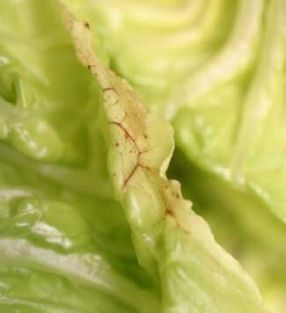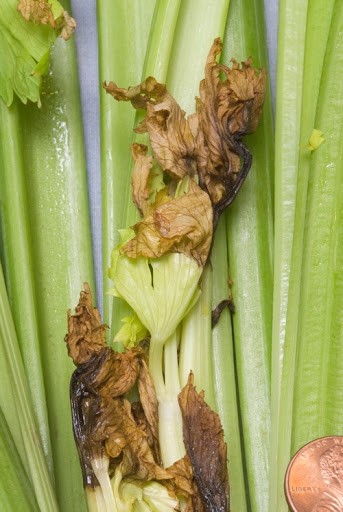Foliar Ca to Alleviate Tipburn and Black Heart in Leafy Vegetables
September 10, 2020
Agronomics / Background
Plant calcium status is an important factor in reducing incidence of tipburn in lettuce and black heart in celery. Calcium plays a critical structural role in the formation and stability of both cell walls and cell membranes. When calcium levels of young internal leaves in leafy vegetables are too low, tissue browning and eventual necrosis can develop. Foliar sprays of calcium that are directly absorbed by the affected tissue can prevent these disorders.
Conditions Leading to Ca Deficiencies
Most leafy vegetables are grown in soils with adequate calcium content. Ca disorders can still occur in immature leaves due to the lack of mobility of Ca within the plant. Calcium is taken into leaf tissue directly from the soil via the transpiration stream in the xylem. Large, outer wrapper leaves have relatively high transpiration rates, and thus do not develop calcium deficiencies. Young, internal leaves have less exposure to air flow and light, which reduces transpiration rates and calcium uptake. Since calcium cannot translocate through the phloem, remobilization of Ca from older leaves is impossible. Low soil moisture can decrease Ca uptake, so proper irrigation is critical to preventing these disorders. Extended periods of fog and cloudy skies, which reduce transpiration rates, also greatly diminish calcium uptake due to the higher relative humidity and lower light exposure.
Excessive fertilization with nitrogen, magnesium, and/or potassium, can increase Ca disorders. Using nitrate nitrogen sources rather than ammonium sources will increase calcium availability.
Desired Ca Tissue Test Values
Wrapper leaves in Romaine lettuce should have a Ca value in the range of 2.0-3.0%. For head lettuce, Ca concentration should be 1.5-2.25%. For outer petioles of celery, 1.3-2.0% is ideal. However, this may not be a good indicator of calcium status of the internal young leaves that are susceptible to tipburn and black heart. Previous experience with particular varieties and fields should be considered when making calcium management conditions. Weather conditions should also be factored in.
Key Application Timings and Rates
If tipburn or black heart are a concern, foliar calcium sprays should begin early and continue at regular intervals. Research on lettuce has shown weekly applications can be quite successful in reducing tipburn incidence. Nozzle arrangement should be made to optimize the amount of material that is getting into the inner portion of the plant so that the spray solution can be directly absorbed by those young leaves. The addition of a good surfactant like BRANDT Super Wetter or BRANDT 719 Spreader can help spread the spray solution and get it into the heart of the plant.
BRANDT Products
BRANDT has several foliar calcium formulations that are highly effective and provide good crop safety:
- Foli-Cal®
- BRANDT® Manni-Plex® Cal Zn
- BRANDT Manni-Plex Cal Mag
- BRANDT Manni-Plex Cal-B
These formulations are all complexed with sugar alcohols to improve nutrient delivery.
BRANDT® Organiplex® 8% Ca is an amino acid complex and is approved for organic use.
For all these formulations, 1-2 quarts per acre per application will work well.

Tipburn on lettuce (source: University of California Agriculture and Natural Resources)

Black heart on celery (source: University of California Agriculture and Natural Resources)
